School History
Fort Hunt Elementary School opened its doors to students in the fall of 1969. Construction of our school was incomplete before the start of school in September, so students were temporarily housed at Stratford Landing and Hollin Hills elementary schools. Approximately 406 children were enrolled at Fort Hunt on opening day.
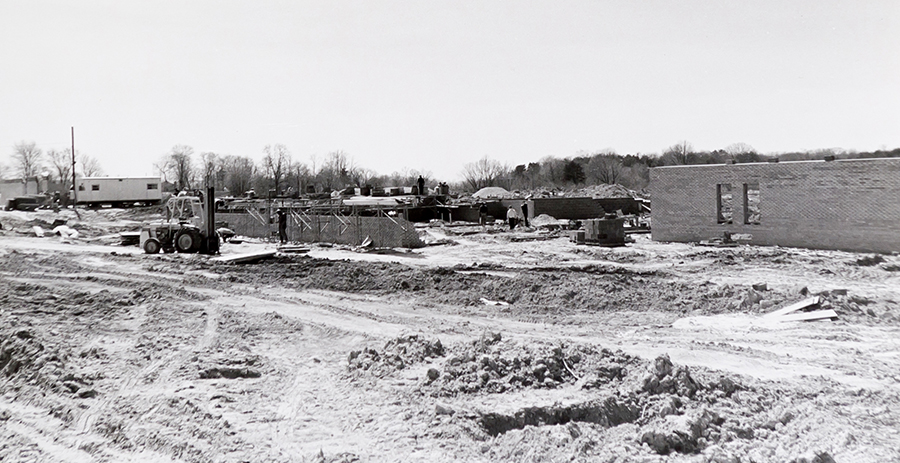
Fort Hunt Elementary School was designed in 1968 by architect William Peake of the firm Spector, Peake, and Howell, and was built by the Burroughs & Preston Construction Company at a cost of $1.1 million. Our school originally had a capacity for approximately 650 students. Fort Hunt’s first principal was Eleanor Hollandsworth. She worked closely with Mr. Peake planning our school, which was one of the first in Fairfax County to introduce the “pod” concept. Originally, the classrooms in this design were “open” and promoted “team teaching.” In the late 1960s, these were terms being introduced in the education field as the upcoming trend. From its inception, Fort Hunt was forward-thinking in design and philosophy.
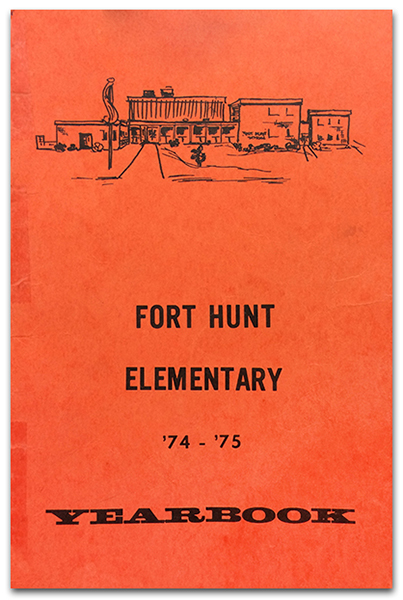
River Farm
Fort Hunt Elementary School was built on land that was once part of River Farm, one of five farms that comprised President George Washington's Mount Vernon Estate. Pictured below is a portion of a map of Mount Vernon drawn by George Washington in 1793. The schoolhouse icon shows the present day location of Fort Hunt Elementary School.
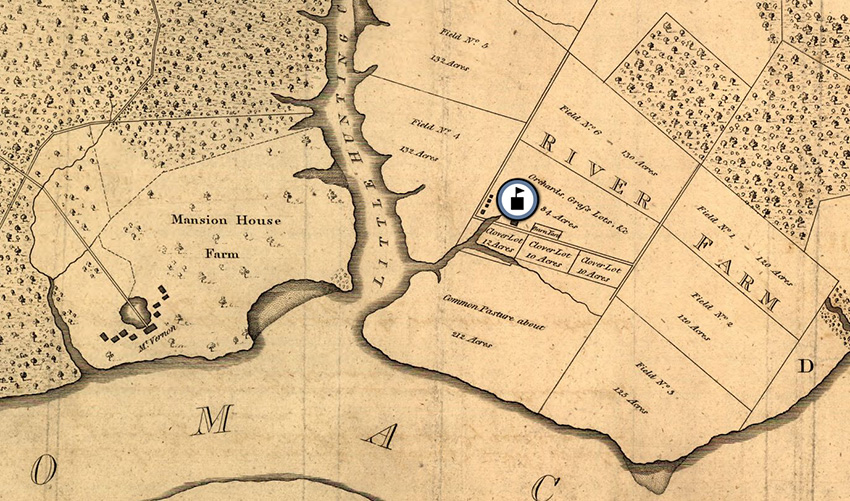
A Tragic Sunday
On Sunday, October 3, 1971, arsonists broke into Fort Hunt Elementary School and set fires in the library and an open classroom learning center. The fire destroyed the library and spread to nearby classrooms, causing extensive smoke damage to much of the building. Only the kindergarten and first grade classrooms were spared. The 707 students enrolled at Fort Hunt that year spent the remainder of the school year largely separated from one another. Children in kindergarten and first grade returned to class in the undamaged part of the building on Tuesday, October 5, 1971, but children in grades 2-6 were split up and sent to Belle View, Stratford Landing, and Waynewood elementary schools. Repair work began in October, and was completed in time for the opening of schools in September 1972.
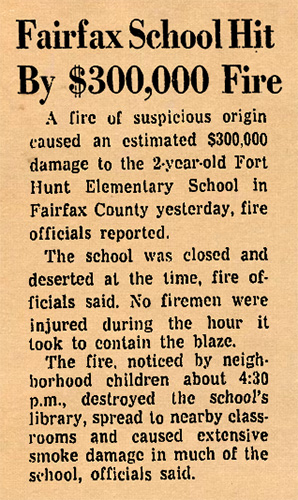
Demographic Changes
Enrollment at Fort Hunt gradually declined in the mid-1970s, falling to a low of 484 in 1977. In 1978, students formerly enrolled at Hybla Valley Elementary School living in the Janna Lee area were bused to Fort Hunt to relieve overcrowding at that school. The redistricting rebounded enrollment at Fort Hunt to approximately 650 students, but enrollment continued to decline in subsequent years, falling to a low of 370 in 1985. The decline in enrollment was driven by the changing demographics among schools in the eastern part of Fairfax County. During the post-World War II “baby boom,” the Route 1 corridor experienced a period of rapid population growth due to an influx of Federal government employees and returning veterans. During the late 1970s, the last children of the baby boom generation were graduating high school, and there were fewer families with young children in the area. This resulted in the closure of several schools during the late 1970s and early 1980s, such as Hollin Hall, Hollin Hills, Virginia Hills, and Wilton Woods elementary schools. One positive outcome of the closings and subsequent redistricting was the further diversification of Fort Hunt’s student body.
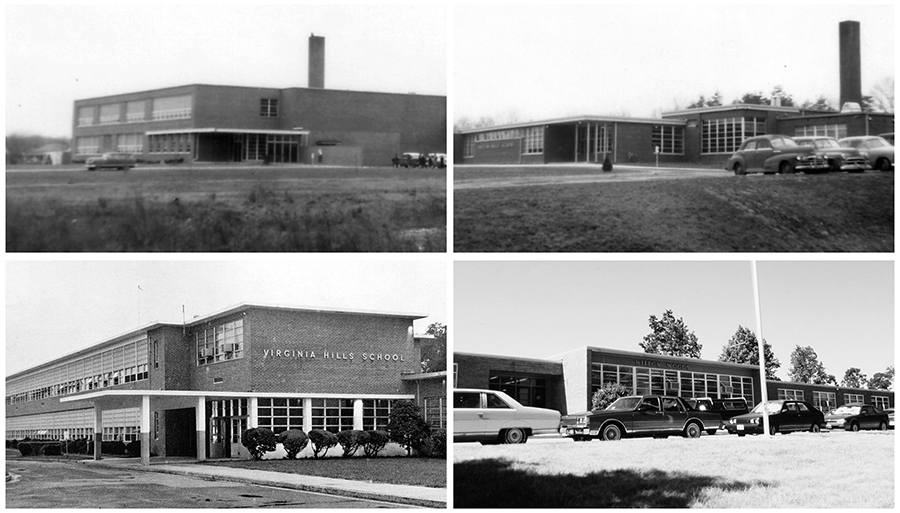
The Eleanor N. Hollandsworth Library
On October 11, 1984, the Fairfax County School Board formally named our library in honor of our school’s first principal, Eleanor Hollandsworth.
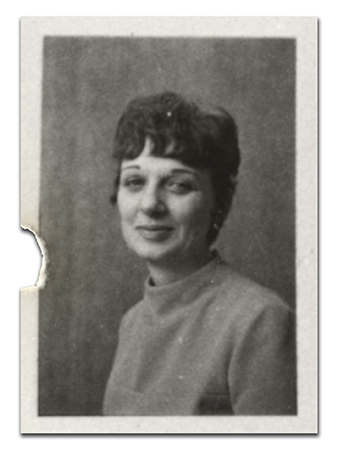
Ms. Hollandsworth was the principal of Fort Hunt from 1969-76. She came to Fort Hunt from Stratford Landing Elementary, where she was principal from 1963-69. Principal Hollandsworth retired after 28 years in Fairfax County Public Schools, having worked as a reading teacher, elementary school teacher, principal, and an area administrator.
Mrs. Hollandsworth worked hard from the start to establish a climate at Fort Hunt that challenged children, stressed the importance of an excellent education, and respected the diversity of students and their families. She carefully selected her staff in order to provide a curriculum to encourage student achievement to its highest potential. Many staff members have bonded together, forming life-long friendships as a result of their shared experience during the past 25 years. We are challenged to uphold Mrs. Hollandsworth’s philosophy.
~Fort Hunt 25th Anniversary Yearbook

Spanish Immersion and the Arts
The Spanish language partial immersion program was first offered during the 1989-90 school year on early release Mondays. In the spring of 1999, Fort Hunt Elementary School was the recipient of a planning grant from the National Foundation for the Improvement of Education and the John F. Kennedy Center for the Performing Arts, to assist with integrating arts education into the curriculum. The resulting program at Fort Hunt was called Changing Education Through the Arts (CETA). Fort Hunt teachers received training at the Kennedy Center, and the Kennedy Center sent specialists, such as professional instrumentalists and conductors, to provide specialized instruction to our students. Strings, band, and art were taught once a week, and all students were afforded the opportunity to participate in music and dramatic productions. CETA made it possible for Fort Hunt to begin teaching strings in third grade and band in fourth grade. Outgrowths of the CETA program included partnerships with the Washington Opera, Mount Vernon Orchestra, and the Washington Metropolitan Philharmonic Orchestra.
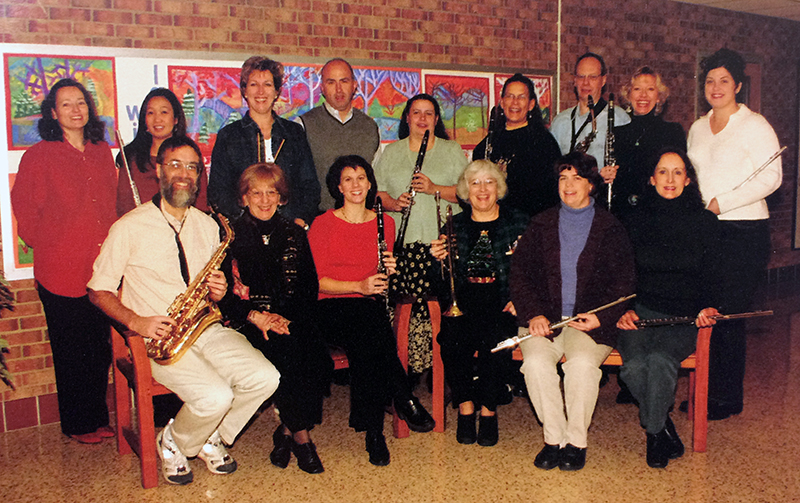
Renovations and Renewed Spirit
The first renovations and additions to Fort Hunt Elementary School were constructed in the 1990s. In 1990, the third grade pod and School Age Child Care classrooms were constructed at a cost of $497,722. From 1995-96, four new classrooms were built, and the library was modernized, at a cost of $575,954. The first building-wide renewal began construction in the summer of 2001, and was completed in 18 months at a cost of $6.9 million. Everything at Fort Hunt was upgraded. A new sprinkler system, new public address system, and new tile were installed throughout the school. The kitchen received new equipment, and a new computer lab was outfitted with state-of-the-art technology. Our school also gained new classrooms, a new library, a black box theatre, and a stage in the auditorium.
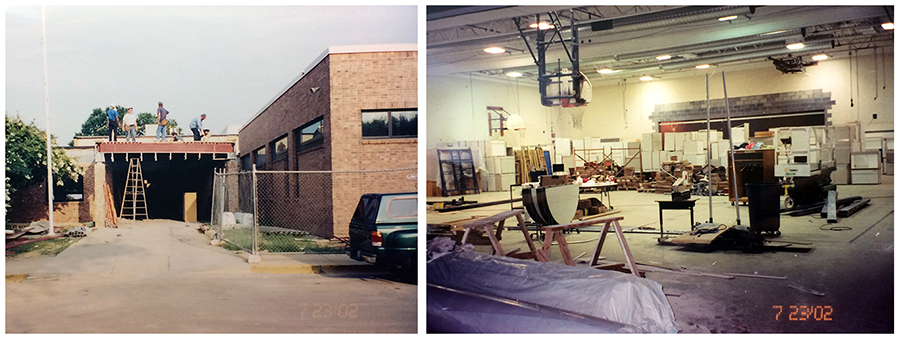
On February 12, 2003, the Fort Hunt community gathered for a renovation celebration. A reporter from the Connection Newspaper was on hand to document the event.
Carol Coose, principal at Fort Hunt Elementary School, knows how to make lemonade out of lemons. Rather than stressing out during the 18 or so months of renovation at her school, she made the best of it. "When the second-graders were studying simple machines, we brought them outside to watch the bricks being loaded on the inclined plane," she said. She invited the contractors into class to speak about their careers and what they were doing to the building. The contractors also figured out a way to incorporate a series of student-designed tiles into the newly-laid wall. "The whole process was not as painful as we thought. We got wonderful people," said Coose.
Watch the changes to our building take shape in this animated series of aerial photographs courtesy of the Fairfax County Park Authority.
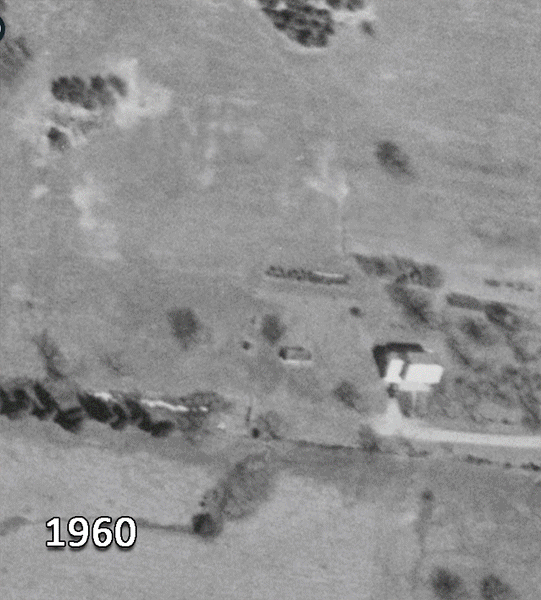
What’s in a Name?
Fort Hunt Elementary School takes its name from a former military installation located nearby along the Potomac River. Learn about the history of the fort, and the man for whom it’s named, in this video produced for Fairfax County Public Schools’ cable television channel Red Apple 21.
Frogs, Ferrets, and Foxes
Did you know that before the year 2000 we were known as the Fort Hunt Patriots instead of the Fort Hunt Foxes? The Patriot mascot was a musket-carrying American Revolutionary War figure. Our current mascot was chosen by the S.C.A. from a list of several alliterative animal names, such as frog and ferret. Several years later a school-wide competition was held to name our mascot, and the winning entry was Artie Z. Fox.

Traditions
Fort Hunt Elementary School has several long-standing school traditions, such as the annual talent show which dates back to at least the 1980s and perhaps earlier. The flag planting ceremony held during our annual Veterans Day observance began in the 1990s. This tradition was started by Principal Carol Coose and Mr. Bill, a World War II veteran and Fort Hunt Elementary crossing guard. On Veterans Day, Mr. Bill would visit our school and speak with students about his military service. He suggested the idea for the flag planting ceremony and organized donations to ensure that every Fort Hunt student would be able to participate. Mr. Bill passed away in 2017.

Our Principals
| 1969 – 1976: | Eleanor N. Hollandsworth |
|---|---|
| 1976 – 1979: | Dumont J. Walker, Jr. |
| 1979: | R. C. Bosley (Acting) |
| 1979 – 1981: | Myrna Ann (Smith) Mayo |
| 1981 – 1986: | Maryanne Roesch |
| 1986 – 1989: | Janet Trout (Barbee) |
| 1989 – 1991: | Elva Hinajosa |
| 1991 – 2009: | Carol Coose |
| 2009 – 2014: | Barbara Leibbrandt |
| 2014 (spring): | Janet LeBel (Interim) |
| 2014 (spring): | Otha L. Davis (Interim) |
| 2014 – Present: | Thomas Fitzpatrick |

